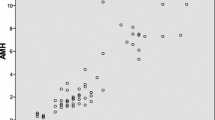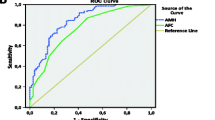Abstract
Purpose
The present study aimed to correlate anti-Müllerian hormone (AMH) levels in follicular fluid (FF) with oocyte maturity stages, morphological quality of metaphase II (MII) oocyte and fertilization capacity of MII oocytes.
Methods
A total of 92 infertile women undergoing controlled ovarian stimulation and intracytoplasmic sperm injection were analyzed. Patients were divided into two groups according to age: <35 years (n = 43) and ≥35 years (n = 49). An FF sample was obtained from a single dominant follicle in each patient for a total of 92 follicular fluid samples analyzed. AMH levels in serum and follicular fluid were measured by enzyme-linked immunosorbent assay. Mature MII oocytes, zygotes, and embryos were assessed for morphological quality.
Results
Serum AMH levels were significantly higher in patients aged <35 years. No correlation was observed between FF AMH level and oocyte maturation stages or morphological quality of MII oocyte. Significantly lower FF AMH levels were observed in fertilized MII oocytes than in non-fertilized MII oocytes in patients aged <35 years (2.56 ± 2.0 ng/ml vs. 4.81 ± 4.14 ng/ml; p = 0.032).
Conclusions
The present study revealed no correlation between FF AMH and oocyte maturity stage or morphological quality of MII oocyte. However, FF AMH might be a predictive marker for fertilization capacity of MII oocytes.
Similar content being viewed by others
References
Gilchrist RB, Lane M, Thompson JG (2008) Oocyte-secreted factors: regulators of cumulus cell function and oocyte quality. Hum Reprod Update 14(2):159–177
Balaban B, Urman B (2006) Effect of oocyte morphology on embryo development and implantation. Reprod Biomed Online 12(5):608–615
Ubaldi F, Rienzi L (2008) Morphological selection of gametes. Placenta 1(29):115–120
Fortune JE (1994) Ovarian follicular growth and development in mammals. Biol Reprod 50(2):225–232
Revelli A, Delle Piane L, Casano S, Molinari E, Massobrio M, Rinaudo P (2009) Follicular fluide content and oocyte quality: from single biochemical markers to metabolomics. Reprod Biol Endocrinol 7:40
Veeck L (1990) The morphological assessment of human oocytes and early concepts. Handb Lab Diagn Treat Infertil
Ebner T, Yaman C, Moser M, Sommergruber M, Feichtinger O, Tews G (2000) Prognostic value of first polar body morphology on fertilization rate and embryo quality in intracytoplasmic sperm injection. Hum Reprod 15(2):427–430
Xia P (1997) Intracytoplasmic sperm injection: correlation of oocyte grade based on polar body, perivitelline space and cytoplasmic inclusions with fertilization rate and embryo quality. Hum Reprod 12(8):1750–1755
Rienzi L, Vajta G, Ubaldi F (2011) Predictive value of oocyte morphology in human IVF: a systematic review of the literature. Hum Reprod Update 17(1):34–45
Broekmans FJ, Kwee J, Hendriks DJ, Mol BW, Lambalk CB (2006) A systematic review of tests predicting ovarian reserve and IVF outcome. Hum Reprod Update 12:685–718
Broer SL, Mol BWJ, Hendriks D, Broekmans FJM (2009) The role of antimullerian hormone in prediction of outcome after IVF: comparison with the antral follicle count. Fertil Steril 91(3):705–714
Nelson SM, Yates RW, Fleming R (2007) Serum anti-Müllerian hormone and FSH: prediction of live birth and extremes of response in stimulated cycles—implications for individualization of therapy. Hum Reprod 22(9):2414–2421
Wunder DM, Guibourdenche J, Birkhäuser MH, Bersinger NA (2008) Anti-Müllerian hormone and inhibin B as predictors of pregnancy after treatment by in vitro fertilization/intracytoplasmic sperm injection. Fertil Steril 90(6):2203–2210
Broer SL, van Disseldorp J, Broeze KA, Dolleman M, Opmeer BC, Bossuyt P et al (2013) Added value of ovarian reserve testing on patient characteristics in the prediction of ovarian response and ongoing pregnancy: an individual patient data approach. Hum Reprod Update 19(1):26–36
Ebner T, Sommergruber M, Moser M, Shebl O, Schreier-Lechner E, Tews G (2006) Basal level of anti-Mullerian hormone is associated with oocyte quality in stimulated cycles. Hum Reprod 21:2022–2026
Irez T, Ocal P, Guralp O, Cetin M, Aydogan B, Sahmay S (2011) Different serum anti-Müllerian hormone concentrations are associated with oocyte quality, embryo development parameters and IVF-ICSI outcomes. Arch Gynecol Obstet 284(5):1295–1301
Lekamge DN, Barry M, Kolo M, Lane M, Gilchrist RB, Tremellen KP (2007) Anti-Müllerian hormone as a predictor of IVF outcome. Reprod Biomed Online 14(5):602–610
Majumder K, Gelbaya TA, Laing I, Nardo LG (2010) The use of anti-Mullerian hormone and antral follicle count to predict the potential of oocytes and embryos. Eur J Obstet Gynecol Reprod Biol 150:166–170
Silberstein T, MacLaughlin DT, Shai I, Trimarchi JR, Lambert-Messerlian G, Seifer DB et al (2006) Müllerian inhibiting substance levels at the time of HCG administration in IVF cycles predict both ovarian reserve and embryo morphology. Hum Reprod 21(1):159–163
Lin W-Q, Yao L-N, Zhang D-X, Zhang W, Yang X-J, Yu R (2013) The predictive value of anti-mullerian hormone on embryo quality, blastocyst development, and pregnancy rate following in vitro fertilization-embryo transfer (IVF-ET). J Assist Reprod Genet 30(5):649–655
Sills ES, Collins G, Brady A, Walsh D, Marron K, Peck A et al (2011) Bivariate analysis of basal serum anti-Mullerian hormone measurements and human blastocyst development after IVF. Reprod Biol Endocrinol 9(1):153
Smeenk JMJ, Sweep FCGJ, Zielhuis GA, Kremer JAM, Thomas CMG, Braat DDM (2007) Antimüllerian hormone predicts ovarian responsiveness, but not embryo quality or pregnancy, after in vitro fertilization or intracyoplasmic sperm injection. Fertil Steril 87(1):223–226
Fong SL, Baart E, Martini E, Schipper I, Visser J, Themmen A et al (2008) Anti-Müllerian hormone: a marker for oocyte quantity, oocyte quality and embryo quality? Reprod Biomed Online 16(5):664–670
Guerif F, Lemseffer M, Couet M-L, Gervereau O, Ract V, Royere D (2009) Serum antimullerian hormone is not predictive of oocyte quality in vitro fertilization. Ann Endocrinol 70(4):230–234
Anckaert E, Smitz J, Schiettecatte J, Klein MB, Arce J-C (2012) The value of anti-Mullerian hormone measurement in the long GnRH agonist protocol: association with ovarian response and gonadotrophin dose adjustments. Hum Reprod 27:1829–1839
Aflatoonian A, Mashayekhy M, Mohamadian F, Mansoori Moghaddam F (2010) The correlation between follicular fluid anti-mullerian hormone levels and fertilization and embryo quality in ART cycles. Iran. J Reprod Med 8(4):157–160
Cupisti S, Dittrich R, Mueller A, Strick R, Stiegler E, Binder H et al (2007) Correlations between anti-Mullerian hormone, inhibin B, and activin A in follicular fluid in IVF/ICSI patients for assessing the maturation and developmental potential of oocytes. Eur J Med Res 12:604–608
Fanchin R, Mendez Lozano DH, Frydman N, Gougeon A, di Clemente N, Frydman R et al (2007) Anti-Müllerian hormone concentrations in the follicular fluid of the preovulatory follicle are predictive of the implantation potential of the ensuing embryo obtained by in vitro fertilization. J Clin Endocrinol Metab 92(5):1796–1802
Jančar N, Virant-Klun I, Vrtačnik Bokal E (2009) Serum and follicular endocrine profile is different in modified natural cycles than in cycles stimulated with gonadotropin and gonadotropin-releasing hormone antagonist. Fertil Steril 92(6):3
Mehta B, Chimote M, Chimote N, Nath N, Chimote N (2013) Follicular-fluid anti-Mullerian hormone (FF AMH) is a plausible biochemical indicator of functional viability of oocyte in conventional in vitro fertilization (IVF) cycles. J Hum Reprod Sci 6(2):99–105
Takahashi C, Fujito A, Kazuka M, Sugiyama R, Ito H, Isaka K (2008) Anti-Müllerian hormone substance from follicular fluid is positively associated with success in oocyte fertilization during in vitro fertilization. Fertil Steril 89(3):586–591
Kedem-Dickman A, Maman E, Yung Y, Yerushalmi GM, Hemi R, Hanochi M et al (2012) Anti-Müllerian hormone is highly expressed and secreted from cumulus granulosa cells of stimulated preovulatory immature and atretic oocytes. Reprod Biomed Online 24(5):540–546
Palermo G, Joris H, Devroey P, Van Steirteghem AC (1992) Pregnancies after intracytoplasmic injection of single spermatozoon into an oocyte. Orig Publ 340(8810):17–18
Balaban B, Ata B, Isiklar A, Yakin K, Urman B (2008) Severe cytoplasmic abnormalities of the oocyte decrease cryosurvival and subsequent embryonic development of cryopreserved embryos. Hum Reprod 23(8):1778–1785
Ebner T, Moser M, Sommergruber M, Tews G (2003) Selection based on morphological assessment of oocytes and embryos at different stages of preimplantation development: a review. Hum Reprod Update 9(3):251–262
Rienzi L, Ubaldi FM, Iacobelli M, Minasi MG, Romano S, Ferrero S et al (2008) Significance of metaphase II human oocyte morphology on ICSI outcome. Fertil Steril 90(5):1692–1700
Wilding M, Matteo L, D’Andretti S, Montanaro N, Capobianco C, Dale B (2007) An oocyte score for use in assisted reproduction. J Assist Reprod Genet 24(8):350–358
Scott L, Alvero R, Leondires M, Miller B (2000) The morphology of human pronuclear embryos is positively related to blastocyst development and implantation. Hum Reprod 15(11):2394–2403
Tesarik J, Greco E (1999) The probability of abnormal preimplantation development can be predicted by a single static observation on pronuclear stage morphology. Hum Reprod 14(5):1318–1323
Zollner U, Zollner K-P, Hartl G, Dietl J, Steck T (2002) The use of a detailed zygote score after IVF/ICSI to obtain good quality blastocysts: the German experience. Hum Reprod 17(5):1327–1333
Hardarson T, Hanson C, Sjögren A, Lundin K (2001) Human embryos with unevenly sized blastomeres have lower pregnancy and implantation rates: indications for aneuploidy and multinucleation. Hum Reprod 16(2):313–318
Van Royen E, Mangelschots K, De Neubourg D, Valkenburg M, Van de Meerssche M, Ryckaert G et al (1999) Characterization of a top quality embryo, a step towards single-embryo transfer. Hum Reprod 14(9):2345–2349
Battaglia DE, Goodwin P, Klein NA, Soules MR (1996) Fertilization and early embryology: influence of maternal age on meiotic spindle assembly oocytes from naturally cycling women. Hum Reprod 11(10):2217–2222
Van Rooij IA, Broekmans FJ, Scheffer GJ, Looman CW, Habbema JD, de Jong FH et al (2005) Serum antimullerian hormone levels best reflect the reproductive decline with age in normal women with proven fertility: a longitudinal study. Fertil Steril 83:979–987
La Marca A, Sighinolfi G, Radi D, Argento C, Baraldi E, Artenisio AC et al (2010) Anti-Müllerian hormone (AMH) as a predictive marker in assisted reproductive technology (ART). Hum Reprod Update 16(2):113–130
Broer SL, Mol B, Dólleman M, Fauser BC, Broekmans FJ (2010) The role of anti-Mullerian hormone assessment in assisted reproductive technology outcome. Curr Opin Obstet Gynecol 22(3):193–201
La Marca A, Papaleo E, D’Ippolito G, Grisendi V, Argento C, Volpe A (2011) The ovarian follicular pool and reproductive outcome in women. Gynecol Endocrinol 28(3):166–169
Anckaert E, Smitz J, Schiettecatte J, Klein BM, Arce J-C (2012) The value of anti-Müllerian hormone measurement in the long GnRH agonist protocol: association with ovarian response and gonadotrophin-dose adjustments. Hum Reprod 27(6):1829–1839
Salmon NA, Handyside AH, Joyce IM (2004) Oocyte regulation of anti-Müllerian hormone expression in granulosa cells during ovarian follicle development in mice. Dev Biol 266(1):201–208
von Wolff M, Kollmann Z, Flück CE, Stute P, Marti U, Weiss B, Bersinger NA (2014) Gonadotrophin stimulation for in vitro fertilization significantly alters the hormone mileu in follicular fluid: a comparative study between natural cycle IVF and conventional IVF. Hum Reprod 29(5):1049–1057
Acknowledgments
The authors thank the Department of Histology and Embryology, Rijeka School of Medicine, University of Rijeka for their support during the study. The authors also thank Marina Merkaš for assistance in statistical analysis. This research was funded by the Ministry of Science, Education and Sport of the Republic of Croatia, grant number 62-00000-3553. The funders had no role in study design, collection, analysis, and interpretation of data, writing of the report and decision to submit the article for publication. The authors had no financial relationship with the organization that sponsored the research.
Conflict of interest
The authors declare that they have no conflict of interest. The authors have full control of all primary data and agree to alow the journal to review data if requested.
Ethical standards
The study design was approved by the Ethics Committee of the Clinical Hospital Center Rijeka, and written consent was obtained from all participants prior to their inclusion in the study. The study was performed in accordance with the ethical standards laid down in the 1964 Declaration of Helsinki. The authors have full control of all primary data and agree to alow the journal to review data if requested.
Author information
Authors and Affiliations
Corresponding author
Rights and permissions
About this article
Cite this article
Tramišak Milaković, T., Panić Horvat, L., Čavlović, K. et al. Follicular fluid anti-Müllerian hormone: a predictive marker of fertilization capacity of MII oocytes. Arch Gynecol Obstet 291, 681–687 (2015). https://doi.org/10.1007/s00404-014-3460-9
Received:
Accepted:
Published:
Issue Date:
DOI: https://doi.org/10.1007/s00404-014-3460-9




